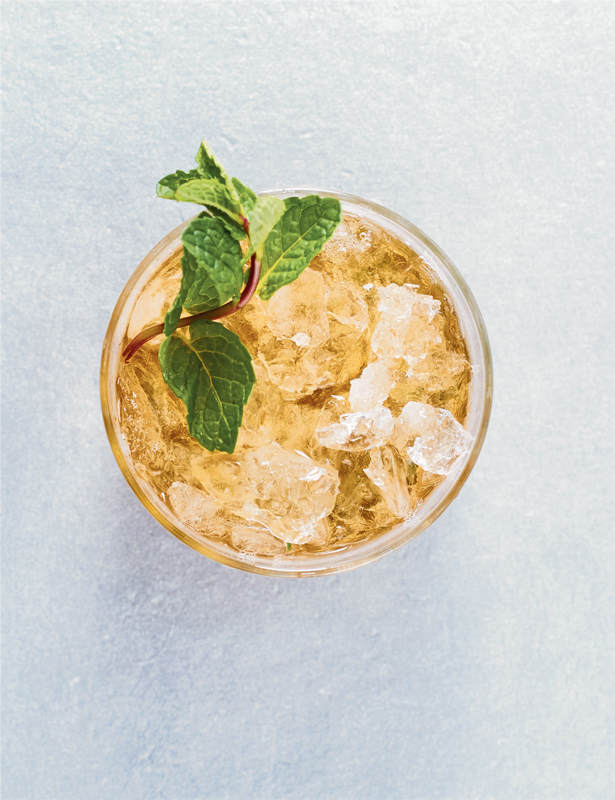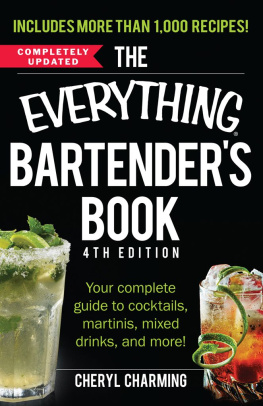
 THE ARTISANAL KITCHEN Holiday COCKTAILS The Best Nogs, Punches, Sparklers, and Mixed Drinks for Every Festive Occasion NICK MAUTONE
THE ARTISANAL KITCHEN Holiday COCKTAILS The Best Nogs, Punches, Sparklers, and Mixed Drinks for Every Festive Occasion NICK MAUTONE  artisan | New York Also in This Series The Artisanal Kitchen: Perfect Pasta The Artisanal Kitchen: Perfect Pizza at Home The Artisanal Kitchen: Vegetables the Italian Way The Artisanal Kitchen: Holiday Cookies The Artisanal Kitchen: Party Food
artisan | New York Also in This Series The Artisanal Kitchen: Perfect Pasta The Artisanal Kitchen: Perfect Pizza at Home The Artisanal Kitchen: Vegetables the Italian Way The Artisanal Kitchen: Holiday Cookies The Artisanal Kitchen: Party Food  Contents (nonalcoholic)
Contents (nonalcoholic)  Introduction M y approach to cocktail makinga focus on balance of flavor and respect for the ingredients that make a drinkis as intense as that of any chef, from when the ingredients are purchased to the moment a cocktail is served to one of my guests. The result must meet the same exacting standards as any dish served in a great restaurant. Unfortunately, too many bars, restaurants, and even people who entertain at home dont feel that way. This is not to say that cocktails must be complicated or difficult to make to be delicious. On the contrary, sometimes the simplest drinks are the most elegant and tasty. Nothing gives me more pleasure than sharing a meal, a drink, and great conversation with friends and family.
Introduction M y approach to cocktail makinga focus on balance of flavor and respect for the ingredients that make a drinkis as intense as that of any chef, from when the ingredients are purchased to the moment a cocktail is served to one of my guests. The result must meet the same exacting standards as any dish served in a great restaurant. Unfortunately, too many bars, restaurants, and even people who entertain at home dont feel that way. This is not to say that cocktails must be complicated or difficult to make to be delicious. On the contrary, sometimes the simplest drinks are the most elegant and tasty. Nothing gives me more pleasure than sharing a meal, a drink, and great conversation with friends and family.
My approach to entertaining is straight-forward: I plan my meals and beverages somewhat thematically. I like to match the before-dinner drinks to the meal and the wine to be served with it. I try to surprise my guests with new and different drinks at unexpected times. I keep a well-stocked bar at home so I can usually accommodate my guests imbibing pleasures. I prefer to plan out an occasion, including the drinks everyone will have, in advance. As my guests arrive, we share drinks perfectly matched to our evening.
Then we move on to the meal, for which I will generally open a good bottle of wine during the first course. While cocktails are a passion, I adore wine with my meals and feel that this is a natural progression for a great dinner. At this point my guests will have finished their before-dinner drinks and had some food, so they can easily switch over to wine, which allows me to spend more time with them. In order to accommodate all of your guests particular preferences, you should always keep some basics on hand. For liquors, keep your favorite brands of vodka, gin, whiskey, rum, tequila, brandy, sweet and dry vermouth, and curaao always at the ready. For extra ingredients, keep olives, seltzer, club soda, tonic water, bitters, superfine sugar, and kosher salt on hand.
Of course, there are hundreds and hundreds of liquors, cordials, and brandies that you could stock, but these basics and extras make literally hundreds of different drinks to satisfy your guests cravings. The rules for pairing wine with food apply to cocktails as well: the cocktail should offer a counterpoint to the dominant characteristics of the food. For example, match rich, creamy foods with cocktails that have bountiful acidity and are full-flavored. The acid cuts through the fats and cleanses the palate. Salty foods demand contrasting elements such as sweetness to balance out the salt. Most cocktails are served before dinner because they are perfect palate openers.
Some cocktails are great after dinner, when they act as a digestif or even as dessert. I generally do not serve cocktails with the meal because as good as cocktails are, their place is before or after the meal, rarely during it. When introducing a wine to your meal after your cocktails, always remember that balance is the key. Great wines (no matter what the price) act as a condiment. If you have served strong cocktails before dinner, try to serve a light wine such as a crisp Alsatian or New York Riesling with your first course. If your cocktails were light and the meal permits, you could enjoy a richer chardonnay with the appetizer.
Remember, the idea is not to get people drunk but to enhance their meal. One universal rule for enjoying company is to prepare as much in advance as possible. For drinks that have both an alcohol and nonalcohol base, mix each component of the drink in a separate container, without any ice, well in advance and store them sealed in the refrigerator. When your guests arrive, you can then mix the two in the correct proportions without any fuss. Even easier are drinks that can be mixed in one container, such as . If you are having a group over, prepare a pitcherful of Manhattans for eight servings, or even more, and store it tightly sealed in the refrigerator, without ice, until ready to serve.
When ready, you can stir or shake one or two servings at a time, allowing you to efficiently serve drinks to order. Whenever I make a large batch of a drink that includes muddled ingredients, I muddle the ingredients with a mortar and pestle or in a large bowl with a wooden spoon and then divide the ingredients evenly among the glasses. I also freeze my fresh-squeezed juices. If I am having a group over on Saturday, I may squeeze all the juices on Wednesday and freeze them immediately. Allow the juice to thaw in the refrigerator overnight before using. The freezing does not negatively affect the juice, and you are still serving a freshly prepared product that will improve the flavor of your drinks.
I have organized the chapters in this book thematically. There is a section of punch recipes perfect for entertaining a large crowd, bubblies for festive occasions, good old classic cocktails with some unexpected variations, hot drinks for winter gatherings, and drinks to serve after dinner in lieu of coffee or dessert. If you are looking for a drink based on a specific liquor, such as vodka, simply consult the index, where you will find the recipes organized by base liquor. I hope you enjoy this book and use it to share many great days and nights entertaining friends and family. Chapter -1 Home Bar Basics  Understanding the basics is the key to being successful in any endeavor. Perfecting basic techniques and using superior ingredients and the proper tools are fundamental to creating an extraordinary drink.
Understanding the basics is the key to being successful in any endeavor. Perfecting basic techniques and using superior ingredients and the proper tools are fundamental to creating an extraordinary drink.
This chapter focuses first on what is perhaps the most important element of a great cocktail: balance. Without balance, a drink might be too sweet, too sour, or even just too big, but it is easy to avoid these excesses and get a grasp on how a properly balanced drink should taste. Next featured are a few basic tools and techniques that facilitate efficient and fun cocktail making. is a straightforward guide to stocking your liquor cabinet with a few well-chosen basics. Consider this chapter a brief but thorough course in great cocktail making. Taking a little time with these home bar basics before tackling the recipes that follow will enhance your experience and improve your results, for on these pages are the necessary building blocks to transform you into a master home bartender, and thats when the fun really begins! A Focus on Balance The first rule of cocktail making is that balance is everything.
In imbibing, balance might be viewed as the ratio of acid to sweetness to alcoholic strength. In the case of wine, those that are too low in acid taste flabby, wines that are too high in alcohol taste hot or medicinal, and wines that are too high in sugar or too low in acid or alcohol taste cloying. These same principles hold true for cocktails. Determining balance in your drinks will also help you understand the characteristics of liquors and mixers. For example, some bourbons are sweeter than others. If you use them in an old-fashioned, you may require less sugar.
Next page








 THE ARTISANAL KITCHEN Holiday COCKTAILS The Best Nogs, Punches, Sparklers, and Mixed Drinks for Every Festive Occasion NICK MAUTONE
THE ARTISANAL KITCHEN Holiday COCKTAILS The Best Nogs, Punches, Sparklers, and Mixed Drinks for Every Festive Occasion NICK MAUTONE  artisan | New York Also in This Series The Artisanal Kitchen: Perfect Pasta The Artisanal Kitchen: Perfect Pizza at Home The Artisanal Kitchen: Vegetables the Italian Way The Artisanal Kitchen: Holiday Cookies The Artisanal Kitchen: Party Food
artisan | New York Also in This Series The Artisanal Kitchen: Perfect Pasta The Artisanal Kitchen: Perfect Pizza at Home The Artisanal Kitchen: Vegetables the Italian Way The Artisanal Kitchen: Holiday Cookies The Artisanal Kitchen: Party Food  Introduction M y approach to cocktail makinga focus on balance of flavor and respect for the ingredients that make a drinkis as intense as that of any chef, from when the ingredients are purchased to the moment a cocktail is served to one of my guests. The result must meet the same exacting standards as any dish served in a great restaurant. Unfortunately, too many bars, restaurants, and even people who entertain at home dont feel that way. This is not to say that cocktails must be complicated or difficult to make to be delicious. On the contrary, sometimes the simplest drinks are the most elegant and tasty. Nothing gives me more pleasure than sharing a meal, a drink, and great conversation with friends and family.
Introduction M y approach to cocktail makinga focus on balance of flavor and respect for the ingredients that make a drinkis as intense as that of any chef, from when the ingredients are purchased to the moment a cocktail is served to one of my guests. The result must meet the same exacting standards as any dish served in a great restaurant. Unfortunately, too many bars, restaurants, and even people who entertain at home dont feel that way. This is not to say that cocktails must be complicated or difficult to make to be delicious. On the contrary, sometimes the simplest drinks are the most elegant and tasty. Nothing gives me more pleasure than sharing a meal, a drink, and great conversation with friends and family. Understanding the basics is the key to being successful in any endeavor. Perfecting basic techniques and using superior ingredients and the proper tools are fundamental to creating an extraordinary drink.
Understanding the basics is the key to being successful in any endeavor. Perfecting basic techniques and using superior ingredients and the proper tools are fundamental to creating an extraordinary drink.